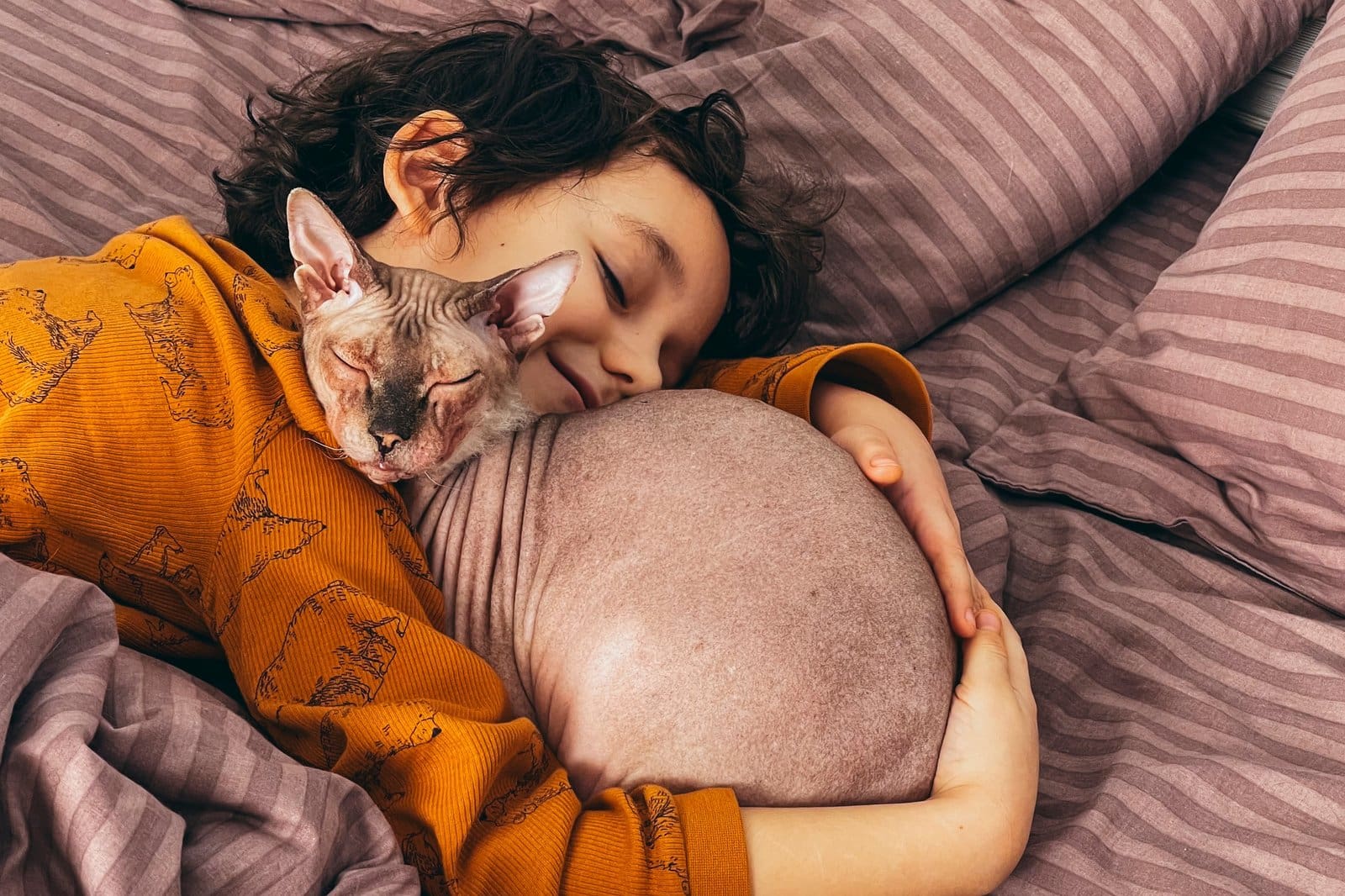Welcome to the World of Hairless Cats
Have you ever met a cat so unique that it turns heads wherever it goes? Welcome to the world of hairless cats, where warmth, charm, and quirkiness come bundled in furless little packages.
In this guide, we’ll introduce some delightful hairless cat breeds, share what makes each special, and help you decide if one of these snuggly naked felines might be your perfect companion.
We speak from experience – as passionate cat lovers at SnuggleSouls, we’ve spent years caring for and learning about these amazing cats, and we’re here to help you understand them in a warm, practical way.
By the end, you’ll not only know the names of popular hairless breeds, but also why they might steal your heart and how to care for them day to day. Let’s dive in!
Quick Glance: Hairless Cats
Before we get into the nitty-gritty, here’s a quick at-a-glance summary of some popular hairless cat breeds and what you can expect from them:
| Breed | Key Personality Trait | Grooming Needs | Energy Level |
|---|---|---|---|
| Sphynx | Affectionate & extroverted | High (weekly baths for oily skin) | Moderate (playful but also cuddly) |
| Bambino | Playful & people-loving | High (needs skincare like Sphynx) | Moderate (short legs slow them a bit) |
| Peterbald | Curious & energetic | High (hairless or sparse coat care) | High (active, enjoys fetch and following you) |
| Donskoy | Intelligent & friendly | High (varied coat types, skin care needed) | Moderate (likes play and cuddles) |
| Lykoi (“Wolf Cat”) | Loyal & sprightly | Moderate (partial coat, occasional baths) | High (active, not a lap-cat) |
| Ukrainian Levkoy | Gentle & loyal | High (hairless skin & folded ears care) | Low–Moderate (calm and quiet companion) |
(Key: High grooming = regular baths, skin moisturization, ear cleaning; Moderate = some special care but less frequent; Energy Level ranges from calm to very active.)
Meet Your Cat: 6 Delightful Breeds
Sphynx
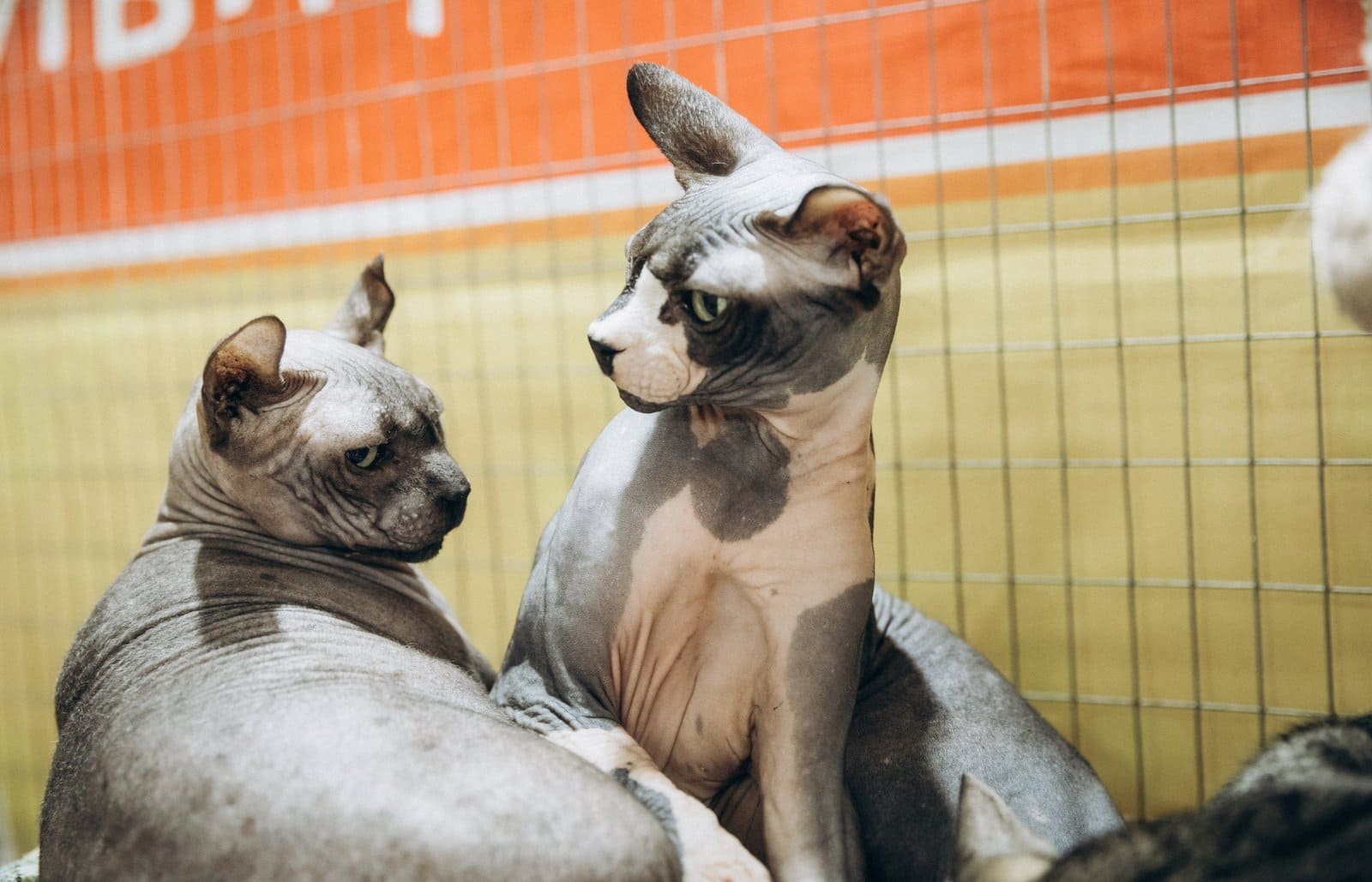
Their Unique Charm
The Sphynx is the iconic symbol of hairless cats, and for good reason. These medium-sized cats are outgoing, playful, and ultra-affectionate – the kind who will greet you (and even your guests) at the door and follow you around the house for company.
Don’t let the regal, ancient-Egyptian look fool you; a Sphynx is more of a clown at heart, always up for a game or a goofy cuddle. They’re also warm – literally! Covered in only a fine peach-fuzz, a Sphynx feels like a toasty chamois or suede hot water bottle against your skin, making them perfect for snuggling on chilly mornings.
This breed originated from a natural genetic mutation in Canada in the 1960s, and today Sphynx cats are recognized by all major cat associations (CFA, TICA, etc.). That means they’ve been bred responsibly enough to have a healthy, diverse gene pool of hairless kitties.
Their extroverted, people-loving nature often shines – Sphynxes get along well with kids, other cats, and even cat-friendly dogs. If you’ve always wanted a cat that acts a bit like a loyal dog and a comedian in one wrinkly, velvety package, the Sphynx might steal your heart.
Is This Your SnuggleSoul?
Do you crave a constant companion? Sphynx cats hate being alone – these bald little buddies will want to be involved in everything you do. They’ll curl up on your lap (or your laptop!), sleep under the covers with you, and demand plenty of playtime and attention. In return, they give endless affection.
However, be honest about your lifestyle. Sphynxes require regular grooming and skincare despite having no fur. Their skin gets oily without weekly baths and wipe-downs, and you’ll need to clean their large ears and even between their toes (yes, they get toe jam from sweat).
If you don’t have the time or desire to commit to these grooming needs – or if you travel a lot and would leave kitty home alone – a Sphynx might not be the best match. But for dedicated owners who work from home or have lots of love to give, a Sphynx will reward you with endless cuddles, entertainment, and devotion.
We’ve found them to be one of the most loving breeds around, truly earning their reputation as a “velcro cat” glued to your side.
Read more about Sphynx
Bambino
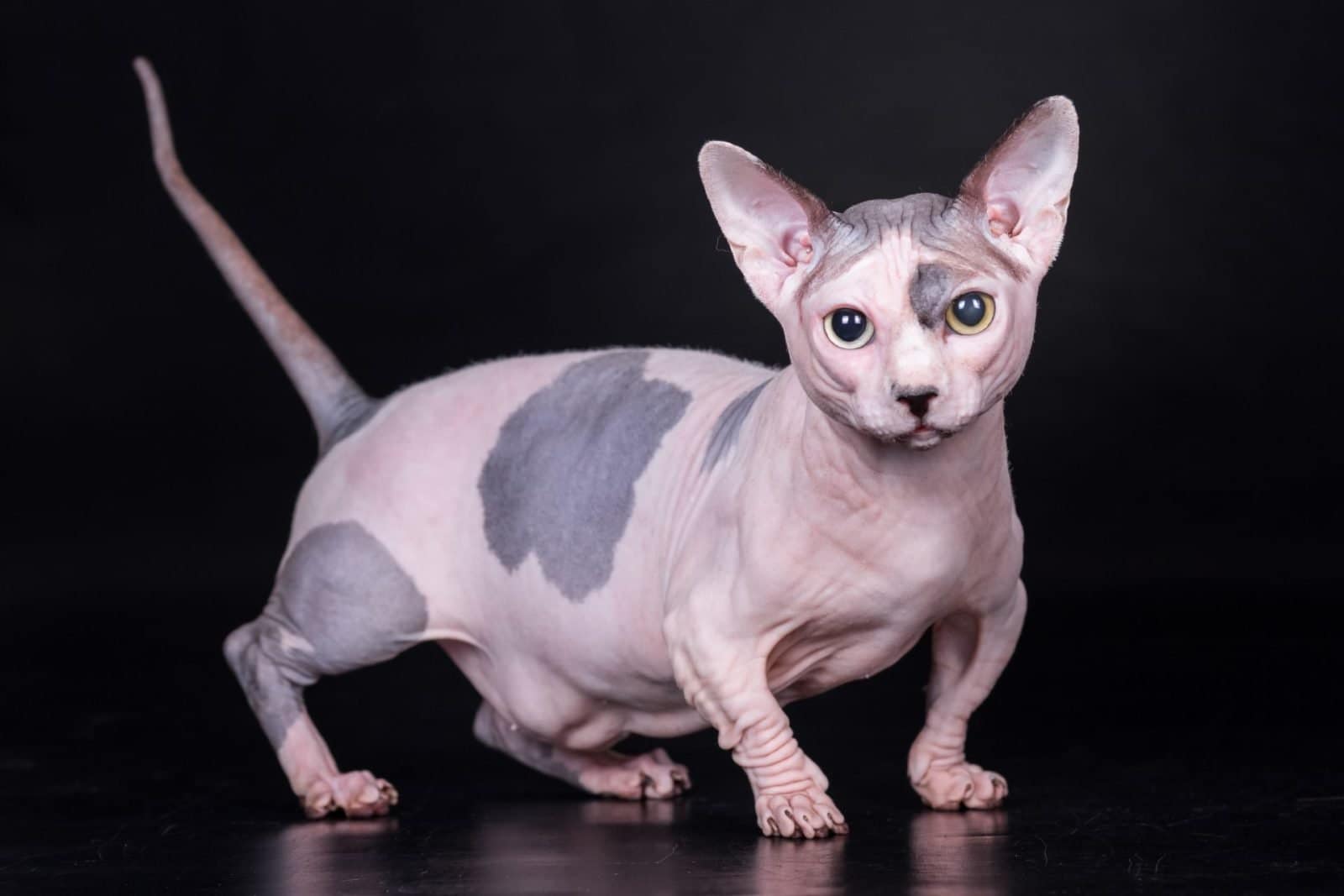
Their Unique Charm
Meet the Bambino, the pint-sized “baby” of the hairless cat world. This newer breed (established around 2005) is a cross between a Sphynx and a Munchkin cat, meaning it’s hairless and short-legged.
Imagine a Sphynx’s affectionate personality on a tiny, dachshund-like body – that’s the Bambino! These cats have huge ears and an endearing elf-like face, often with a peach-fuzz touch on the ears, muzzle, or tail.
What they lack in height, they make up in personality: Bambinos are friendly, outgoing, and love to play. In fact, they truly crave human interaction and attention, often following their people around and begging for snuggles or play sessions.
Don’t be surprised if your Bambino hops (on those short legs) right into bed with you or invents a silly game of fetch. Their sociable, clownish nature can bring a lot of laughter to your home. Physically, they might have a touch of hair on the face or paws, but mostly they’re as naked as their Sphynx parents – just fun-sized!
Is This Your SnuggleSoul?
A Bambino could be your soul-cat if you’re looking for a devoted lap cat with a playful streak. These kitties adore being coddled by their humans, so they fit well in a family that has plenty of time to dote on them.
Keep in mind that because of their short stature, Bambinos might not leap to the top of your bookshelf – but they’ll happily wrestle toys on the floor and find creative ways to climb shorter perches. Daily interactive play is recommended to keep their muscly little bodies fit and their minds enriched.
Also, note that Bambinos are still considered an experimental breed (not yet accepted by major registries like CFA). There’s some controversy in the cat world about breeding for multiple mutations (hairlessness and dwarfism), so finding a reputable breeder is key if you go this route.
Potential owners should also be aware that those stubby legs can predispose Bambinos to joint or spinal issues as they age. This means you’ll want to prevent them from doing high jumps and keep an eye on their mobility.
If you’re ready for the extra vet care that might entail, plus the usual hairless cat skincare (yes, Bambinos need baths and sunscreen just like Sphynxes), then you’ll find a big heart in this tiny package. Many Bambino parents (including some of our team) will tell you these cats are worth the effort – their affectionate gaze and kitten-like playfulness well into adulthood can melt anyone’s heart.
Peterbald
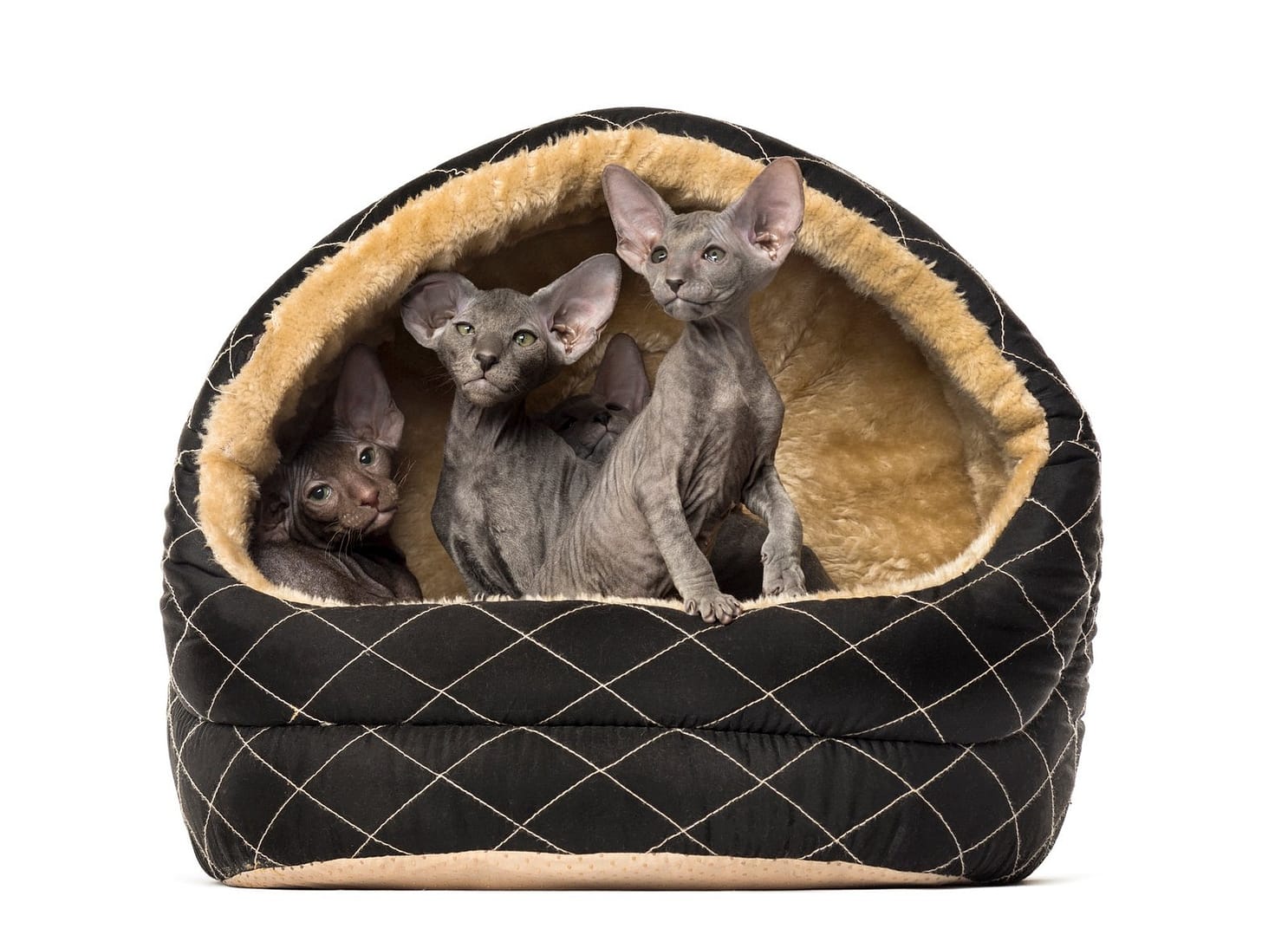
Their Unique Charm
Elegant, exotic, and lively – the Peterbald is often described as “a ballerina in a cat’s body.” With a slender, graceful build inherited from its Oriental Shorthair ancestry and the hairless gene from the Donskoy, the Peterbald is a Russian-born breed combining the best of both worlds.
One look at a Peterbald and you’ll notice oversized ears, almond-shaped eyes, and a curious expression that says, “Let’s play!” These cats are rare outside of Russia, but wherever they are, they tend to charm everyone with their friendly, inquisitive nature.
Don’t be surprised if your Peterbald follows at your heels around the house; they form strong bonds with their guardians and hate to miss out on any action. An interesting quirk: not all Peterbalds are completely bald. Their coats can range from totally hairless “ultra-bald,” to a soft fuzzy or velour coat.
Regardless of coat type, Peterbalds carry themselves with an almost aristocratic poise, paired with kitten-like energy. They were accepted by TICA (The International Cat Association) in 2005, a testament to the breed’s growing popularity among enthusiasts.
Is This Your SnuggleSoul?
If the idea of an extroverted, playful sidekick who might as well be a furry (or sometimes not-so-furry) shadow appeals to you, the Peterbald could be your match. These cats thrive in homes where they can be involved in everything – from supervising your work to “helping” with household chores.
They are also famously vocal and chatty; a Peterbald will tell you all about their day with a range of meows and trills. In our experience, they’re wonderful for families or individuals who want a cat with a lot of personality and a high activity level.
Just be ready: a bored Peterbald can get into mischief, so provide lots of toys, climbing spots, and interactive play. When they finally tire out, they do enjoy a warm lap or curling up under blankets with you (especially if they are one of the balder ones and need the warmth).
Like all hairless or part-hairless breeds, Peterbalds require routine grooming – even those with a bit of fur may get oily skin. You’ll need to wipe them down and bathe periodically, and make sure they’re protected from chill and sunburn (imagine a kitty in a stylish sweater – that’s a Peterbald in winter!).
This breed offers a truly interactive and loving pet experience for the right owner.
Donskoy
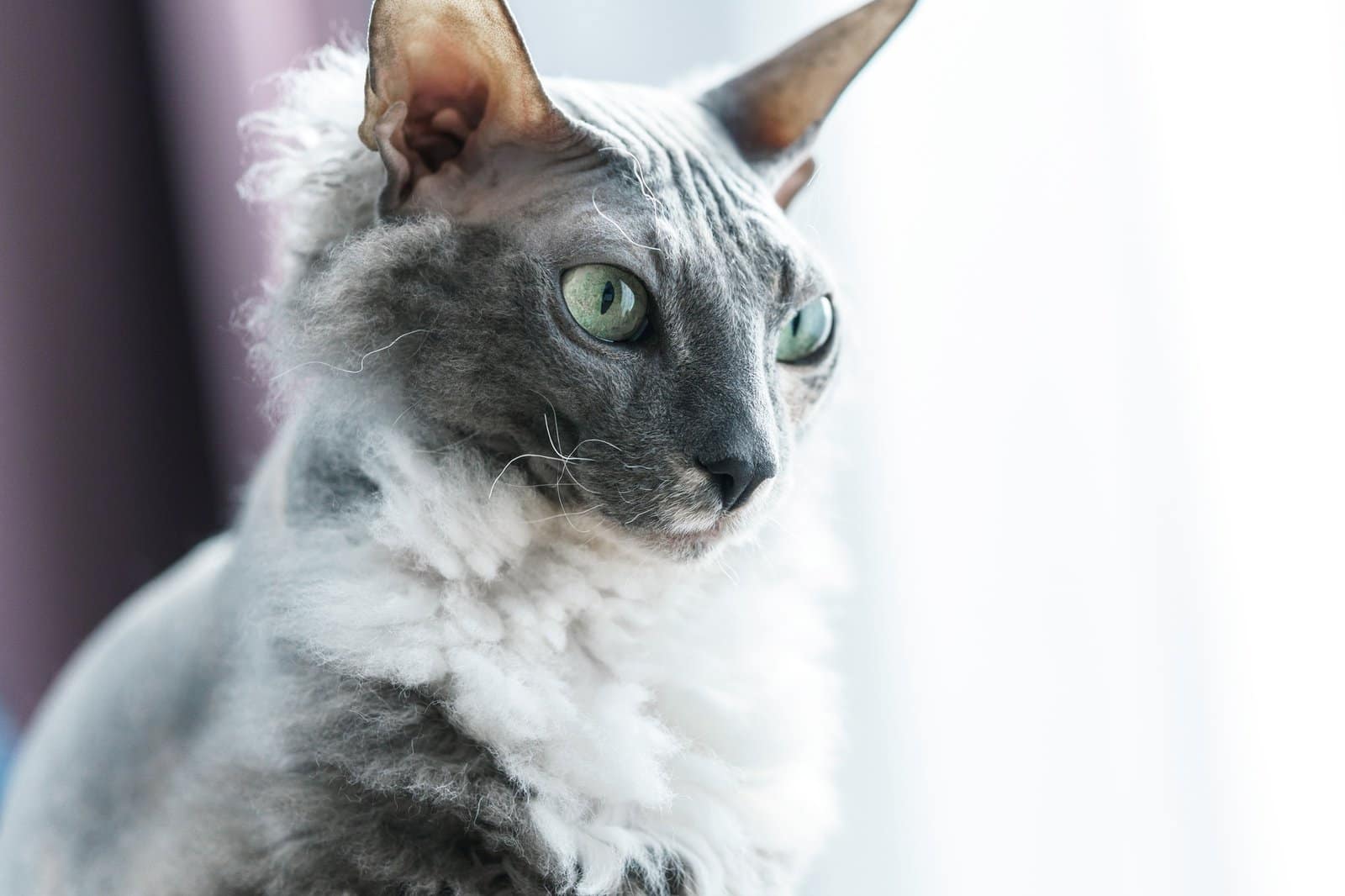
Their Unique Charm
Hailing from the city of Rostov-on-Don in Russia, the Donskoy (also known as the Don Sphynx) is another captivating hairless breed with a big heart.
Discovered in 1987, this breed has a different genetic quirk from the Sphynx – the Donskoy’s hairlessness comes from a dominant gene (meaning if one parent is Donskoy, kittens can be hairless), whereas the Sphynx’s is recessive.
What does this mean for you as an owner? Well, Donskoy kittens can actually be born with various types of coat: some are “rubber-bald” (totally naked) and stay that way, while others have a peach-fuzz or velour coat that they shed as they mature, potentially ending up bald or with only a bit of fur on the extremities.
There’s even a “brush coat” Donskoy that keeps a wiry short coat in patches – truly a breed full of surprises! In terms of personality, Donskoys are known to be highly intelligent and easy to train, often picking up tricks or leash walking with ease.
Many owners describe them as having a dog-like personality, eager to please and very interactive with their family. A Donskoy will play fetch, come when called, and loves puzzle toys that challenge its mind. But don’t worry, they have a soft side too – Donskoy cats adore cuddling and can be very gentle and sweet with children and other pets. They tend to fit well into family life.
Physically, aside from their lack of fur, you’ll notice their large almond eyes and strong, muscular build. In winter some Donskoys even grow a bit of fuzzy coat (like a built-in sweater) on their chest or tail, then shed it in warm weather – how neat is that?
While not yet accepted by CFA or some western registries, TICA accepted the Donskoy in 2016, so its popularity is spreading.
Is This Your SnuggleSoul?
A Donskoy could be ideal for you if you’re looking for a trainable, engaging pet that might meet you at the door wagging an (invisible) tail.
We sometimes joke that Donskoy owners have the best of both worlds: a cat that’s independent enough to lounge in a sunbeam, but social enough to play fetch and follow you like a pup. These cats do well in active households because they truly bond with their people and can even get along swimmingly with kids, other cats, and respectful dogs.
Just remember, attention is their lifeblood. A Donskoy left alone all day with nothing to do can become anxious or destructive; they really need companionship or enrichment (having another pet friend can help).
In terms of care, you’re signing up for the usual hairless-cat routine: regular baths, skin care, and temperature protection. We’ve found Donskoys to be a touch less oily than Sphynx on average (especially those with partial coats), but they still appreciate a good wipe-down and absolutely will hog the heater or your sweater in cold weather.
If you live somewhere chilly, plan on investing in some cute cat sweaters (and yes, many Donskoys tolerate or even enjoy wearing them!). One more thing to consider is availability – Donskoys are still relatively rare in some countries, so finding one might take patience or networking with specialty breeders or rescues.
If you do bring one home, you’ll be rewarded with a devoted, clever companion who keeps you on your toes and in your heart, all at once.
Lykoi
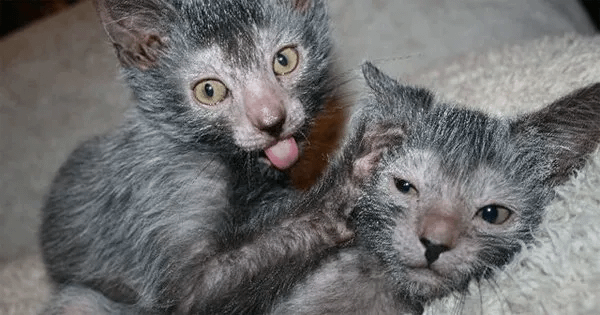
Their Unique Charm
If you’ve ever dreamed of a little werewolf curled up on your sofa, the Lykoi might just be your fantasy come true. Nicknamed the “wolf cat,” the Lykoi sports a wild, scruffy appearance – a sparse salt-and-pepper coat with an often hairless “mask” around the eyes, nose and muzzle.
In fact, Lykoi cats go through dramatic coat cycles, sometimes molting most of their fur (“wolfing out”) and then regrowing it later. At times, a Lykoi might look almost completely hairless; at other times, they have a thin coat of soft, bristled guard hairs that give them a roan-grey, werewolf-like look. (Don’t worry, though – despite the patchy hair, they don’t howl at the moon… much .)
Lykoi are still very rare – as of a couple years ago, there were fewer than 100 show-quality Lykoi worldwide, and while their numbers are growing, expect to pay a premium if you find a kitten (often $1,000 or more). Now, beyond the intriguing appearance, Lykoi have wonderful personalities. They are often described as loyal, intelligent, and playful.
Owners often say these cats are highly bonded to their family and curious about everything happening around them. They might not be classic “lap cats” who sit still all day (there’s too much mischief to do!), but they will follow you room to room and cuddle on their terms (which, honestly, makes each snuggle feel extra special).
Is This Your SnuggleSoul?
A Lykoi could be the one if you’re fascinated by the out-of-the-ordinary and are prepared for a cat that might sometimes look a bit patchy or “homeless” – we think it’s all part of their charm, but it can surprise visitors!
From a care perspective, Lykoi have some advantages: since they aren’t completely hairless, they usually don’t get as oily as Sphynx or Donskoy cats, and they may not need as frequent baths.
However, they lack an undercoat, so they can still get a bit greasy and will appreciate occasional bathing or at least brushing/wiping to remove excess oils. They shed what hair they do have in cycles, meaning you might find clumps of their sparse fur during a “molt” but then very little shedding at other times.
Temperament-wise, think about whether you’d enjoy a cat that’s high-energy and inquisitive. Lykois are great for owners who want an interactive pet; they’ll play games, learn tricks, and keep you laughing. They’re also generally social with people if well-socialized early (as with any breed) and can be loving companions.
If you have other pets, Lykois often do well, since they have the confidence to engage in play. Just be sure any dog friends know this “werewolf” is family, not prey! One important factor: because Lykois are so rare, you might have to join a waitlist or consider adopting an older Lykoi. Occasionally retired breeders or rescues have Lykois looking for homes (a specialized rescue could be a route).
Overall, if you’re up for something a little wild-looking but very warm-hearted, the Lykoi could be your perfect snuggle buddy under that full moon (or, you know, on the couch watching movies with you!).
Read more about Lykoi
Ukrainian Levkoy

Their Unique Charm
The Ukrainian Levkoy is a breed that can make you do a double-take – you might think you’re looking at a tiny hairless puppy at first! With their distinctive folded ears and nearly hairless bodies, Levkoys have an appearance that pet owners often describe as “so ugly it’s cute,” in the most affectionate way.
This breed was developed in Ukraine in the early 2000s by crossing the Donskoy (hairless) with the Scottish Fold (folded ears), resulting in a truly one-of-a-kind look: a wrinkled face, wide-set eyes, and ears that fold forward like a Scottish Fold’s, all on a mostly bald body.
The name “Levkoy” comes from a type of plant with curled leaves that the cat’s ears resemble. Because they’re a mix of breeds, not all Levkoy kittens have folded ears – some end up with straight ears, and only those with the signature fold have that quintessential Levkoy look.
Personality-wise, Levkoys are often praised for their gentle, easygoing nature. Many owners report they are friendly, sweet, and loyal companions who bond closely with their families. A Levkoy tends to be a bit more low-key than, say, a Peterbald or Sphynx – they enjoy quiet company and might happily sit nearby while you read or work, content just to be in the same room as you.
They are sociable without being overly demanding. Don’t get us wrong, they still love to play at times (they are cats, after all), but they might not zoom around the house as much as some other breeds. Instead, you’ll find your Levkoy quietly following you from room to room, curling up next to you on the sofa, and gently soliciting pets with a soft headbutt.
Since the breed is quite new and not recognized by major registries like CFA or TICA yet, Levkoys are still very rare (mainly found in Eastern Europe or in specialty catteries). Their rarity might make them a conversation piece, but it also means prospective owners should do their homework to find ethical breeders.
Is This Your SnuggleSoul?
A Ukrainian Levkoy could be a dream match for someone seeking a calm, devoted feline friend with a truly distinctive appearance. These cats are a great fit if you prefer a pet that’s affectionate but not hyperactive – think of them as the quietly observant sidekick who’s always there, but not in your face.
They typically tolerate solitude a bit better than some hairless breeds (like Sphynx or Donskoy), meaning if you have a 9-to-5 job they might nap and be okay, though they’ll definitely greet you warmly when you return (and probably stick to you like glue for the rest of the evening).
When it comes to care, Levkoys share the usual hairless cat needs: skin care and temperature control. In fact, those folded ears need attention too – just like Scottish Folds, Levkoys can be prone to some cartilage or joint issues due to the folding gene.
It’s crucial that breeders only pair folded-ear cats with straight-ear cats to avoid serious health problems. So if you’re considering a Levkoy, ensure the breeder follows these practices. Also be aware that the fold gene can bring the risk of arthritis or joint pain in adulthood, so regular vet checkups are important to catch any issues early.
Levkoys are generally healthy otherwise, with hearty appetites (they have a fast metabolism like many hairless cats) and a love of cozy spots. You’ll want to have soft blankets and maybe a heated cat bed for them, as they can get chilly without fur. If you live in a cold climate, a little sweater is definitely your Levkoy’s friend.
All in all, if you’re enchanted by the Levkoy’s unusual look and loving demeanor, and you’re prepared for the effort it takes to care for a hairless, folded-ear kitty, you’ll likely form a very deep bond.
In our experience, Levkoy owners become totally smitten with this breed – their cats’ loyalty and sweet nature often exceed expectations. It’s a special feeling to be one of the few with a Levkoy companion, and to give them a life full of warmth (literally and figuratively!).
Our Promise to You: A Lifetime of Snuggles
At SnuggleSouls, our mission is simple: to help you find and enjoy a lifetime of snuggles with the right feline friend. Whether you’re drawn to the spirited Sphynx, the tiny Bambino, or the mellow Levkoy, we’re here to support you every step of the way.
Our team has decades of combined experience in cat care, behavior, and nutrition – and we’ve poured our hearts into raising and rehabilitating cats of all breeds (hairless or otherwise). We promise to share honest, practical guidance so you feel confident and prepared as a pet parent.
Bringing a new cat home, especially a special one like a hairless breed, can be as challenging as it is rewarding. But remember, you’re never alone on this journey. We’re with you through all the cozy nights and even the occasional messy bath times.
By choosing a SnuggleSoul, you become part of our family – a community that believes every cat deserves understanding, patience, and endless love. Here’s to many purrs, head-butts, and warm snuggles in your future!
Want to learn more?
Ready to keep learning? We’ve got you covered. Check out our Beginner’s Guide to Cat Adoption for tips on bringing home a new feline family member, or explore our Cat Breed Encyclopedia for deeper dives into each cat personality type.
Our resources are built to help you become the best cat parent you can be. Knowledge is love in action – and we’re thrilled to help you on your quest to love your cat even better.
Find Your Purr-fect Match Among All Cat Breeds
At SnuggleSouls, we believe every cat deserves a forever home—and every cat lover deserves the perfect feline companion. Whether you’re drawn to the charm of small cat breeds, the balanced nature of medium cats, or the majestic presence of large cat breeds, we’ve got detailed guides to help you choose wisely.
Prefer grooming to be a breeze? Check out our picks for shorthair cat breeds, hairless cats, and low-shedding breeds. Longing for luxurious coats? Our longhair cat breed guide might just melt your heart.
If you or your family members have allergies, don’t worry—we’ve also curated a trusted list of hypoallergenic cat breeds that might work better for sensitive households.
Explore all our breed guides to find the snuggle soul that’s truly meant for you.
FAQ
Are hairless cats truly hypoallergenic?
Not completely. They still produce allergens, but some allergy sufferers tolerate them better due to less shedding.
Do hairless cats need baths?
Yes! Hairless cats need weekly baths to remove oil and dirt buildup on their skin.
Do hairless cats get cold easily?
Yes. Without fur, they need warm environments, heated beds, or cozy clothes to stay comfortable.
Are hairless cats good with families and kids?
Absolutely. Most are social, affectionate, and great with children and other pets if properly socialized.
How much does a hairless cat cost?
Prices range from $1,000–$2,000 from breeders, but rescues or retired breeders may offer adoption options.
Can I adopt a hairless cat instead of buying one?
Yes! Breed-specific rescues and rehoming networks sometimes have Sphynx or other hairless breeds available for adoption.
Which hairless cat breed is the most affectionate?
The Sphynx is often considered the most affectionate, known for following owners around and craving attention.

